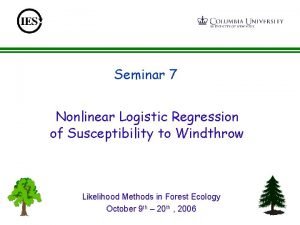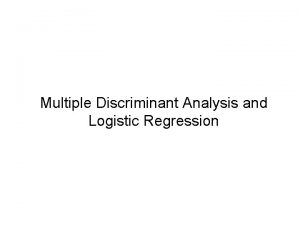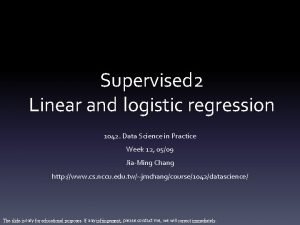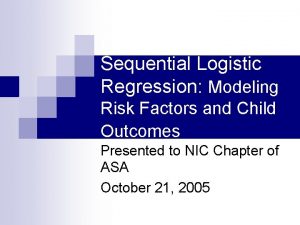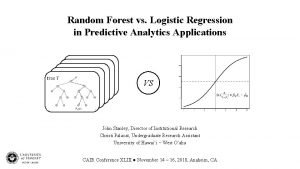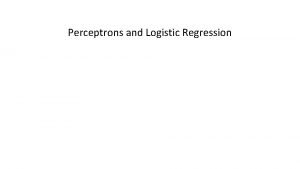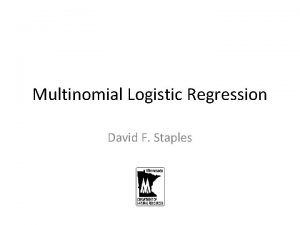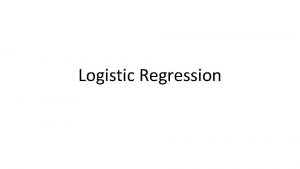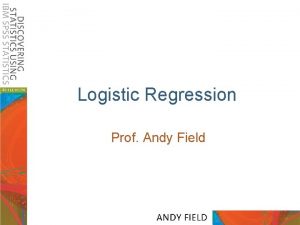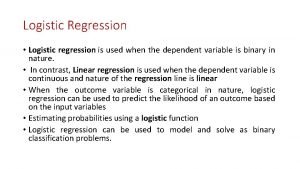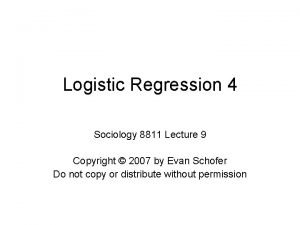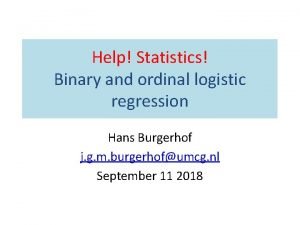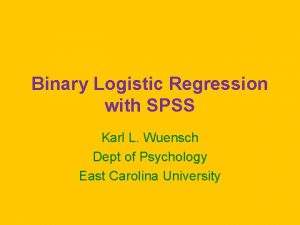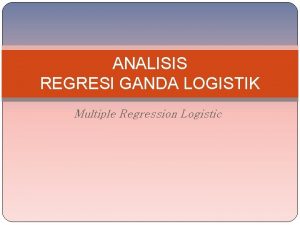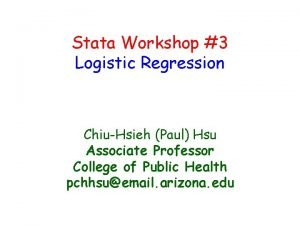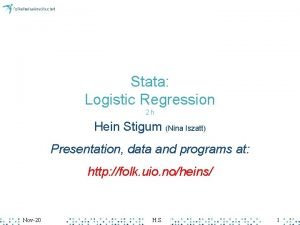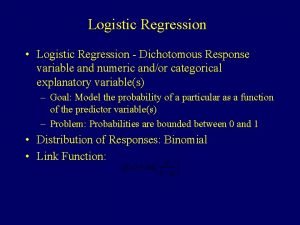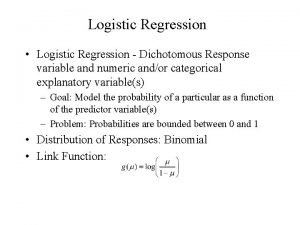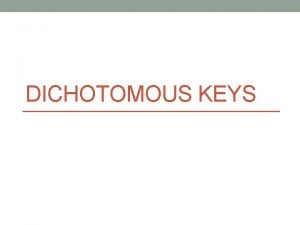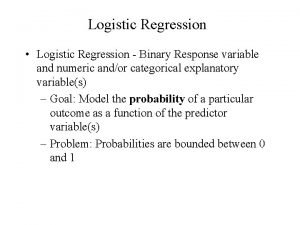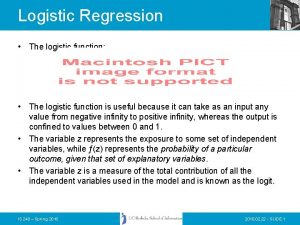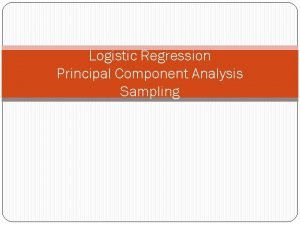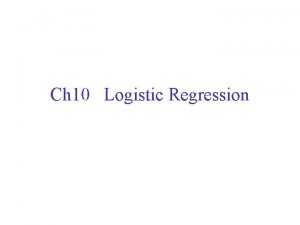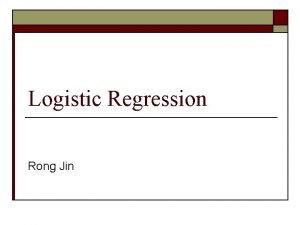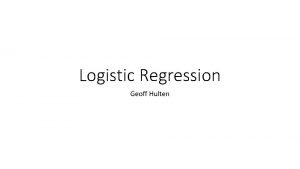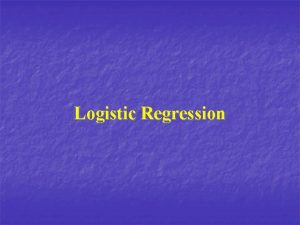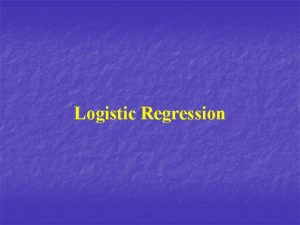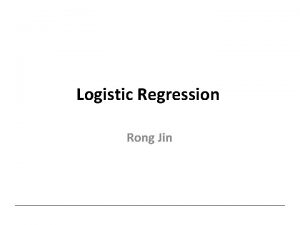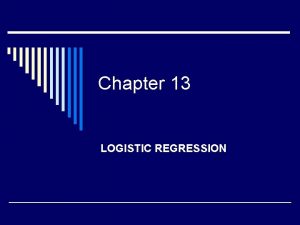Logistic and Nonlinear Regression Logistic Regression Dichotomous Response


















- Slides: 18

Logistic and Nonlinear Regression • Logistic Regression - Dichotomous Response variable and numeric and/or categorical explanatory variable(s) – Goal: Model the probability of a particular as a function of the predictor variable(s) – Problem: Probabilities are bounded between 0 and 1 • Nonlinear Regression: Numeric response and explanatory variables, with non-straight line relationship – Biological (including PK/PD) models often based on known theoretical shape with unknown parameters

Logistic Regression with 1 Predictor • Response - Presence/Absence of characteristic • Predictor - Numeric variable observed for each case • Model - p(x) Probability of presence at predictor level x • b = 0 P(Presence) is the same at each level of x • b > 0 P(Presence) increases as x increases • b < 0 P(Presence) decreases as x increases

Logistic Regression with 1 Predictor · a, b are unknown parameters and must be estimated using statistical software such as SPSS, SAS, or STATA · Primary interest in estimating and testing hypotheses regarding b · Large-Sample test (Wald Test): · H 0: b = 0 H A: b 0

Example - Rizatriptan for Migraine • Response - Complete Pain Relief at 2 hours (Yes/No) • Predictor - Dose (mg): Placebo (0), 2. 5, 5, 10 Source: Gijsmant, et al (1997)

Example - Rizatriptan for Migraine (SPSS)

Odds Ratio • Interpretation of Regression Coefficient (b): – In linear regression, the slope coefficient is the change in the mean response as x increases by 1 unit – In logistic regression, we can show that: • Thus eb represents the change in the odds of the outcome (multiplicatively) by increasing x by 1 unit • If b = 0, the odds and probability are the same at all x levels (eb=1) • If b > 0 , the odds and probability increase as x increases (eb>1) • If b < 0 , the odds and probability decrease as x increases (eb<1)

95% Confidence Interval for Odds Ratio • Step 1: Construct a 95% CI for b : • Step 2: Raise e = 2. 718 to the lower and upper bounds of the CI: • If entire interval is above 1, conclude positive association • If entire interval is below 1, conclude negative association • If interval contains 1, cannot conclude there is an association

Example - Rizatriptan for Migraine • 95% CI for b : • 95% CI for population odds ratio: • Conclude positive association between dose and probability of complete relief

Multiple Logistic Regression • Extension to more than one predictor variable (either numeric or dummy variables). • With p predictors, the model is written: • Adjusted Odds ratio for raising xi by 1 unit, holding all other predictors constant: • Inferences on bi and ORi are conducted as was described above for the case with a single predictor

Example - ED in Older Dutch Men • Response: Presence/Absence of ED (n=1688) • Predictors: (p=12) – Age stratum (50 -54*, 55 -59, 60 -64, 65 -69, 70 -78) – Smoking status (Nonsmoker*, Smoker) – BMI stratum (<25*, 25 -30, >30) – Lower urinary tract symptoms (None*, Mild, Moderate, Severe) – Under treatment for cardiac symptoms (No*, Yes) – Under treatment for COPD (No*, Yes) * Baseline group for dummy variables Source: Blanker, et al (2001)

Example - ED in Older Dutch Men Interpretations: Risk of ED appears to be: • Increasing with age, BMI, and LUTS strata • Higher among smokers • Higher among men being treated for cardiac or COPD

Nonlinear Regression • Theory often leads to nonlinear relations between variables. Examples: – 1 -compartment PK model with 1 st-order absorption and elimination – Sigmoid-Emax S-shaped PD model

Example - P 24 Antigens and AZT • Goal: Model time course of P 24 antigen levels after oral administration of zidovudine • Model fit individually in 40 HIV+ patients: where: • E(t) is the antigen level at time t • E 0 is the initial level • A is the coefficient of reduction of P 24 antigen • kout is the rate constant of decrease of P 24 antigen Source: Sasomsin, et al (2002)

Example - P 24 Antigens and AZT • Among the 40 individuals who the model was fit, the means and standard deviations of the PK “parameters” are given below: • Fitted Model for the “mean subject”

Example - P 24 Antigens and AZT

Example - MK 639 in HIV+ Patients • Response: Y = log 10(RNA change) • Predictor: x = MK 639 AUC 0 -6 h • Model: Sigmoid-Emax: • where: • b 0 is the maximum effect (limit as x ) • b 1 is the x level producing 50% of maximum effect • b 2 is a parameter effecting the shape of the function Source: Stein, et al (1996)

Example - MK 639 in HIV+ Patients • Data on n = 5 subjects in a Phase 1 trial: • Model fit using SPSS (estimates slightly different from notes, which used SAS)

Example - MK 639 in HIV+ Patients
 Nonlinear logistic regression
Nonlinear logistic regression Survival analysis vs logistic regression
Survival analysis vs logistic regression Logistic regression vs linear regression
Logistic regression vs linear regression Logistic regression and discriminant analysis
Logistic regression and discriminant analysis Null deviance vs residual deviance
Null deviance vs residual deviance Sequential logistic regression
Sequential logistic regression Logistic regression in predictive analytics
Logistic regression in predictive analytics Perceptron logistic regression
Perceptron logistic regression Multinomial logistic regression
Multinomial logistic regression Cost function logistic regression
Cost function logistic regression Andy field logistic regression
Andy field logistic regression Logistic function
Logistic function Multinomial logistic regression
Multinomial logistic regression Logistic regression epidemiology
Logistic regression epidemiology Hans burgerhof
Hans burgerhof Multiple logistic regression spss
Multiple logistic regression spss Analisis regresi logistik berganda
Analisis regresi logistik berganda Logistic regression stata
Logistic regression stata Logistic regression stata
Logistic regression stata
